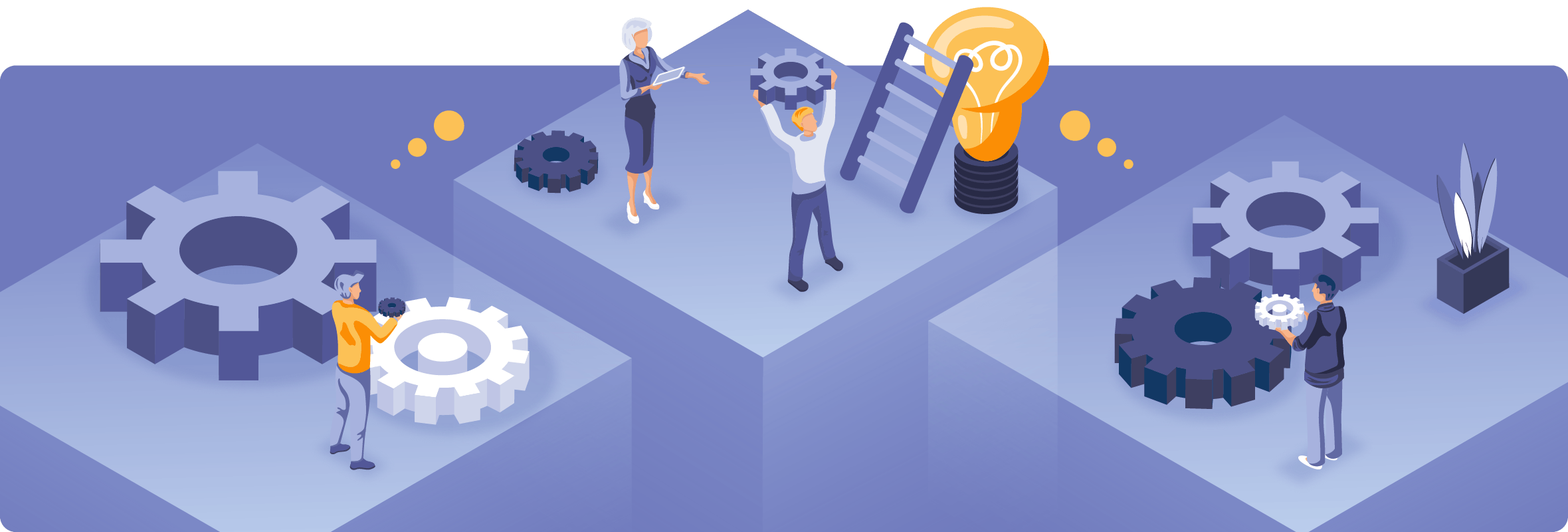What is legal operations?
Legal operations is everything that it takes to run a law firm aside from the actual practice of law. It encompasses strategic planning, legal project management, financial oversight, and legal industry expertise.
The goal of legal operations is to improve law firm performance. Legal operations experts cover a broad range of fields, including data analytics and reporting, engineering, finance, and marketing. Operations professionals work with law firm management to choose the right legal technology, identify and manage risks, and monitor compliance. And above all else, their goal is to deliver value, whether that’s through keeping costs down or increasing productivity and efficiency.[/vc_column_text][/vc_column][/vc_row][vc_row type="in_container" full_screen_row_position="middle" column_margin="default" scene_position="center" text_color="dark" text_align="left" overlay_strength="0.3" shape_divider_position="bottom" bg_image_animation="none"][vc_column column_padding="no-extra-padding" column_padding_position="all" background_color_opacity="1" background_hover_color_opacity="1" column_link_target="_self" column_shadow="none" column_border_radius="none" width="1/1" tablet_width_inherit="default" tablet_text_alignment="default" phone_text_alignment="default" overlay_strength="0.3" column_border_width="none" column_border_style="solid" bg_image_animation="none"][vc_column_text]The seemingly sage advice to “run your law firm like a business” misses the mark. Law firms are businesses. They exchange services (and sometimes goods if they’ve productized their services) for money. They also meet the standard definition of a “business,” which is an organization engaged in commercial or professional activities.
So why have so many law firms resisted the idea of acting like the businesses they are?
Some lawyers claim it’s because the law is a noble profession. But, it’s more likely that law school doesn’t teach them how to run a business. Many aren’t well-versed in financial principles. They don’t value measurements and metrics.
For too long, lawyers have focused on practice, not process. But in recent years, clients have forced law firms to take a hard look at the numbers, their productivity, and their operational efficiency. With competition at an all-time high and clients demanding better service at a lower cost, it’s essential for law firms to rethink their business model.
Enter legal operations.
How has legal operations evolved over the years?
In the late 1980s to early 1990s, legal operations was a fledgling concept among in-house counsel, with corporate legal departments primarily focused on managing outside counsel.
Over time, that focus shifted. By the mid-2000s, corporate law departments were starting to look to legal operations for strategic insights into their outside counsel spend and risk profile.
In the last 20 years, the role of legal operations has become much more prominent, helping organizations manage complex legal issues and retaining the services of legal service providers to drive efficiency and lower costs. These issues continue to be focal points today, along with one more: establishing a culture of continuous improvement.
Today’s clients continue to place pressure on law firms to deliver competitive pricing and better service. In response, firms are striving to maximize their resources so they can do more with less. Now, law firms have adopted much of this mindset, looking for ways to reduce costs, automate processes, and drive greater efficiencies.
What are the key functions of a legal operations role or team?
The Corporate Legal Operations Consortium (CLOC) has identified 12 key legal operations functions. Though CLOC envisioned these practices would be implemented by in-house legal teams, most apply to legal operations roles in law firms today.
Here is a list of the typical functions:
- Business intelligence: Using data to make better decisions, including using data analytics to identify opportunities to optimize firm processes and workflows and to focus the practice on understanding clients’ needs.
- Financial management: Developing budgets and forecasts to improve predictability and encourage the responsible usage of resources.
- Vendor management: Choosing and onboarding the right service providers, negotiating fair pricing models, and performing due diligence on prospective vendors.
- Information governance: Creating policies for sharing and retaining information, managing data security, and ensuring compliance.
- Knowledge management: Giving lawyers and staff access to accurate, up-to-date information for matters and firm business as well as capturing the knowledge of team members.
- Organization optimization and health: Creating a firm culture based on clear values, building a pipeline of leadership talent, and strengthening teams by creating a hiring strategy designed to recruit a mix of skills and perspectives.
- Practice operations: Assigning work strategically so everyone is using their skills and working at the top of their capabilities.
- Program/project management: Enabling the firm to lead firmwide initiatives, such as setting new policies or directing projects and programs, and managing change without distracting from the firm’s core work.
- Service delivery models: Creating a sourcing model that matches the right work to the right resource.
- Strategic planning: Prioritizing projects that align with market trends, client needs, and competitive forces.
- Technology: Transforming manual or repetitive processes with automation, finding new ways to solve problems, and integrating tools to improve client work and firm oversight.
- Training and development: Equipping employees for success with effective onboarding and engaging employees with continuing development opportunities.
All of these functions may be combined within a department, or they may be carried out separately under the oversight of a legal operations manager.
What challenges do legal ops professionals face? How can these be solved?
The biggest challenge that legal operations professionals face is change management. The law is a system based on precedent and law firms are no exception. Lawyers are generally change-averse and prefer to maintain the status quo. It’s hard to convince lawyers that they need to do something differently, especially if what they’ve always done seems to still be working.
Other challenges include budgeting and resource allocation. Law firm leaders are often reluctant to add budget items or headcount to new initiatives, especially if they’re still skeptical about the value that a legal operations team can provide.
Tackling these challenges will require you to establish a business case for a legal operations role or team. If you can quantify the payoff in terms of time saved (automating manual processes with technology), dollars saved (optimizing vendor pricing), and client satisfaction (knowledge sharing and more efficient staffing), you’ll be more likely to convince firm leaders that legal operations is worth the investment.
Recruiting a strong leader with a finance background, technological acumen, and legal experience, whether as a practicing attorney or as a leader in another firm, can lend the department credibility. And, of course, getting quick wins on small projects early can prove value and increase the likelihood of buy-in on more ambitious projects.
How does legal operations increase efficiency?
Legal operations helps law firms drive efficiency across the board.
Between timekeeping, billing, and accounting, law firms have a lot to manage financially. That’s not even including client demands for lower rates and alternative fee arrangements! Legal operations can help firms build financial models that help choose optimal fee arrangements that please clients while yielding a profit. They can also compare firm vendors and help structure competitively priced deals.
In other words, legal operations helps law firms create more value.
On the operational front, legal operations rescues overworked staff from a variety of tasks, including contract management, knowledge management, and data governance. Legal operations professionals can help firms choose the right solutions to capture and track information to ensure nothing falls through the cracks, empowering lawyers and other staff to do more with less.
Law firms are known for being reactive. But, legal operations allows firms to adopt a more proactive approach. For example, legal operations can use data analytics and reporting to predict the right course, set reasonable goals and metrics, and develop a long-term strategic plan to improve the firm’s market position.
Can legal operations software be used to improve performance?
Law firms often invest in solutions serially, looking to solve one problem at a time, but with legal operations software, the key is to find a comprehensive solution that can evolve along with your law firm.
Effective legal operations software for law firms should handle solutions such as e-billing, timekeeping, accounting, matter management, document management, reporting, and client portals. The more interconnected these systems are, the more intelligence they deliver, and the better your firm’s results will be. It’s even better if the legal operations platform integrates with other systems, allowing firms even greater insight into matters and projects while enabling seamless client service.
Comprehensive legal operations software solutions help law firms save time, reduce costs, and improve client service. Some of the ways that law firms can use legal operations software to enhance their performance include the following:
Strong law firms can use the efficiencies generated by legal operations software to differentiate themselves in a crowded market. With the right legal operations tools in place, firms can improve their client service and deliver greater value.[/vc_column_text][/vc_column][/vc_row]




